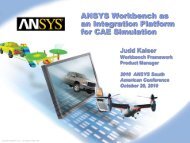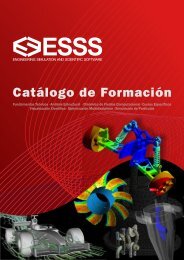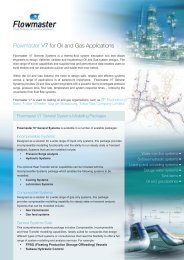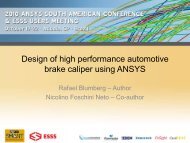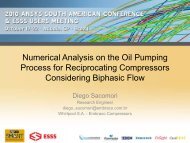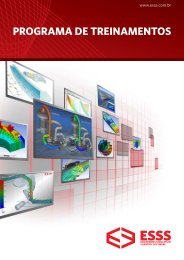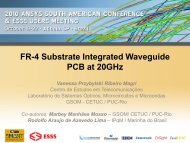Diapositiva 1 - ESSS
Diapositiva 1 - ESSS
Diapositiva 1 - ESSS
Create successful ePaper yourself
Turn your PDF publications into a flip-book with our unique Google optimized e-Paper software.
NUMERICAL COUPLING BETWEEN DEM<br />
(DISCRETE ELEMENT METHOD) AND FEA<br />
(FINITE ELEMENTS ANALYSIS).<br />
Daniel Schiochet Nasato - <strong>ESSS</strong><br />
Prof. Dr. José Roberto Nunhez – Unicamp<br />
Dr. Nicolas Spogis - <strong>ESSS</strong><br />
Fabiano Nunes Diesel - <strong>ESSS</strong>
Agenda<br />
• Objectives<br />
• DEM Method<br />
• EDEM ANSYS Coupling<br />
• Validation and real case<br />
• Conclusions
Objectives<br />
• Develop an 1-way coupling between<br />
Discrete Element Method (DEM) and<br />
Finite Element Method (FEM).<br />
• Propose a numerical validation to evaluate<br />
the method accuracy.<br />
• Simulate a transfer chute using the<br />
developed method to solve a real problem.
DEM Method<br />
• Governing equations for the translational and rotational<br />
motion of particle i with mass m i and moment of inertia I i :<br />
• v i and ω i are the translational and angular velocities of particle i,<br />
• F c ij and M ij are the contact force and torque acting on particle i by particle j<br />
or walls,<br />
• F nc ik is the noncontact force acting on particle i by particle k or other<br />
sources,<br />
• F f i is the particle–fluid interaction force on particle i,<br />
• F g i is the gravitational force.
DEM Contact Detection<br />
• To detect contacts between particles and structure, EDEM splits the<br />
geometry in triangular surface mesh (StL file format), a 3-dimensional<br />
surface geometry;<br />
• The surface is tessellated or broken down logically into a series of<br />
small triangles (facets);<br />
• Each facet is described by a perpendicular direction and three points<br />
representing the vertices (corners) of the triangle.
EDEM-ANSYS Coupling<br />
• EDEM was used as Discrete Element Method (DEM) tool and ANSYS<br />
was used as Finite Element Method (FEM) tool.
EDEM-ANSYS 1-way coupling<br />
Setup ANSYS Model<br />
Run EDEM Model<br />
Create Named<br />
Surface<br />
Export EDEM<br />
Loads<br />
Interpolate Loads<br />
Python Script<br />
And ANSYS APDL<br />
Solve and Evaluate<br />
ANSYS Results
EDEM-ANSYS coupling methods<br />
Developed<br />
• 1-Way DEM-FEA<br />
– Coupling - Steady State<br />
– Static Structural Analysis<br />
• 1-Way DEM-FEA<br />
– Coupling - Transient<br />
– Transient Structural Analysis<br />
Under development<br />
• 2-Way DEM-FEA<br />
– Coupling - Transient<br />
Force<br />
Displacement
Interpolation Method<br />
• Load is transferred from EDEM to ANSYS using a conservative<br />
interpolation;<br />
• Each element face is divided into n number of IP faces, where n is the<br />
number of nodes on the face;<br />
• IP faces are converted onto a two-dimensional polygon;<br />
• Polygons on the sending side are intersected with the IP polygons on<br />
the receiving side;<br />
• The polygon intersection creates many overlapped areas used to<br />
transfer loads between the two sides.
Interpolation Method<br />
• During interpolation, the total force balance over the surface is<br />
preserved.<br />
• For loss less data transfer between particle and structural code, both<br />
numerical models must be coincident in space
Validation Tests<br />
• It was built a small box with 1x1x1m in EDEM and it was created 2000<br />
particles with 40mm diameter and 2500kg/m 3 density;<br />
• It was performed 3s of simulation to ensure that particles have no<br />
velocity in Y direction;<br />
• Total forces (X, Y and Z) and surface mesh nodes position are<br />
exported from EDEM in a single time step.<br />
• Force on Y direction calculated on EDEM was compared with<br />
analytical results.
Validation Tests<br />
• Test 1 - ANSYS coarse mesh,<br />
EDEM coarse mesh<br />
• Test 2 - ANSYS intermediate mesh,<br />
EDEM coarse mesh<br />
• Test 3 - ANSYS refined mesh,<br />
EDEM coarse mesh<br />
Analytical EDEM force Test 1 - Coarse Test 2 - Intermediate Test 3 - Refined<br />
Force Y (N) 1643,8 1645,8 1575,2 1617,6 1663,5<br />
Error % 0,1 4,3 1,7 1,1
Industrial Application<br />
•Geometry directly imported<br />
from CAD on ACIS (.sat)<br />
format.<br />
•Simulation:<br />
•Conveyor belt<br />
•Transfer chute<br />
•Vibrating screens<br />
•Dynamics:<br />
•Sinusoidal translation<br />
•Sinusoidal rotation<br />
•Moving plane (for belt)
EDEM Results
Screen force distribution<br />
High impact velocities zones<br />
(up to 7 m/s) on screen.<br />
Wear and structural problems.<br />
High forces on chute discharge.
EDEM-ANSYS coupling<br />
The developed scripts and macros automatically interpolates EDEM forces<br />
(normal and tangential) on the structural elements.
Static Structural Analysis<br />
Total Deformation<br />
Equivalent Strain<br />
The Static Analysis performed shows stresses &<br />
Strains under the yield limit OK
Conclusions<br />
• EDEM ANSYS Coupling showed good results;<br />
• For numerical validation error was smaller than 5%;<br />
• EDEM ANSYS Coupling showed great potential to<br />
be used as a commercial tool.<br />
– Interpolation takes a few minutes to be done for big<br />
simulations cases.



